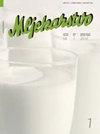Antimicrobial resistance of Staphylococcus aureus strains isolated from cow raw milk samples from Albania and Serbia
IF 1.1
4区 农林科学
Q3 AGRICULTURE, DAIRY & ANIMAL SCIENCE
引用次数: 5
Abstract
This research aimed to determine the prevalence rate of antimicrobial resistance (AMR) of Staphylococcus aureus isolated from raw cow milk samples in Albania and Serbia. A total of 100 raw milk samples, 50 from Albania and 50 from Serbia, have been collected from randomly selected cattle farms. Twelve samples (12 %) were positive for S. aureus, five of those originating from Albania (41.66 %) and seven from Serbia (58.33 %). Resistance of isolated S. aureus strains to ampicillin in milk samples from Albania (36.7 %) and Serbia (34.1 %) was the most common. Some of S. aureus strains from milk samples from Albania were resistant to tetracycline (16.9 %), while isolates from milk samples from Serbia were more resistant towards oxacillin (18 %). The recorded resistance towards erythromycin (13.2 %; 13.1 %), and sulfatrim (7.6 %; 6.9 %) was similar between both milk samples, respectively. The obtained results have shown higher resistance of S. aureus strains towards cephalothin in milk samples from Serbia (3.9 %) compared to milk samples from Albania (1.6 %), respectively. All isolates tested for antibiotic sensitivity were susceptible to methicillin, vancomycin, chloramphenicol, and ciprofloxacin. The obtained results regarding the minimum inhibitory concentrations (MICs) of antibiotics indicated that isolates were resistant to tetracycline, oxacillin, erythromycin, and ampicillin, respectively. Results of our investigation have shown that the found antibiotics residues are related to the usage of erythromycin (72.6 % and 73.9 %), followed by ampicillin (70.4 % and 71.2 %) while residues of ciprofloxacin in the analysed milk samples was not registered.从阿尔巴尼亚和塞尔维亚的牛奶样品中分离出的金黄色葡萄球菌菌株的耐药性
本研究旨在确定从阿尔巴尼亚和塞尔维亚的生牛乳样本中分离出的金黄色葡萄球菌的抗微生物耐药性(AMR)的流行率。从随机选择的养牛场共采集了100份生乳样本,其中50份来自阿尔巴尼亚,50份来自塞尔维亚。12个样本(12%)对金黄色葡萄球菌呈阳性,其中5个来自阿尔巴尼亚(41.66%),7个来自塞尔维亚(58.33%)。阿尔巴尼亚(36.7%)和塞尔维亚(34.1%)的牛奶样本中分离的金黄色葡萄球菌对氨苄青霉素的耐药性最为常见。来自阿尔巴尼亚的牛奶样本中的一些金黄色葡萄球菌菌株对四环素具有耐药性(16.9%),而来自塞尔维亚的牛奶样本的分离株对苯唑西林更具耐药性(18%)。两种牛奶样品对红霉素(13.2%;13.1%)和磺胺吡啶(7.6%;6.9%)的耐药性相似。所获得的结果显示,与阿尔巴尼亚的牛奶样品(1.6%)相比,塞尔维亚的牛奶样品中金黄色葡萄球菌菌株对头孢噻吩的耐药性分别较高(3.9%)。所有测试抗生素敏感性的分离株都对甲氧西林、万古霉素、氯霉素和环丙沙星敏感。所获得的关于抗生素的最小抑制浓度(MIC)的结果表明,分离株分别对四环素、苯唑西林、红霉素和氨苄青霉素具有耐药性。我们的调查结果表明,发现的抗生素残留与红霉素的使用有关(72.6%和73.9%),其次是氨苄青霉素(70.4%和71.2%),而分析的牛奶样品中的环丙沙星残留没有登记。
本文章由计算机程序翻译,如有差异,请以英文原文为准。
求助全文
约1分钟内获得全文
求助全文
来源期刊

Mljekarstvo
Agricultural and Biological Sciences-Animal Science and Zoology
CiteScore
1.90
自引率
41.70%
发文量
18
审稿时长
12 weeks
期刊介绍:
Mljekarstvo is an open access, peer-reviewed international quarterly scientific journal. The first issue was published in 1951, by the Croatian Dairy Operators'' Association (today: Croatian Dairy Union, publisher). In a paper at a Union conference held 28 October 1951 in Zagreb it was said: "Our desire is that this magazine does not meet the fate of its predecessors, but that it continues to reflect the creative efforts and to provide guidelines for the producers as well as all other operators employed in the dairy industry."
It is our pleasure today to say that wishes of the enthusiasts who attended the conference have come true, and the magazine Mljekarstvo during the last six decades was a reflection of the creative efforts of numerous dairy scientists and experts, and through its texts it served as a guideline in improving production and processing of milk and dairy products. Mljekarstvo has been following all the achievements of the dairy profession in Croatia, and it also gives the short surveys of world achievements. The result of the research of local and foreign scientists and experts always find their place in the magazine Mljekarstvo. It has been edited by our outstanding dairy experts employed at colleges, research institutions and dairy companies.
 求助内容:
求助内容: 应助结果提醒方式:
应助结果提醒方式:


